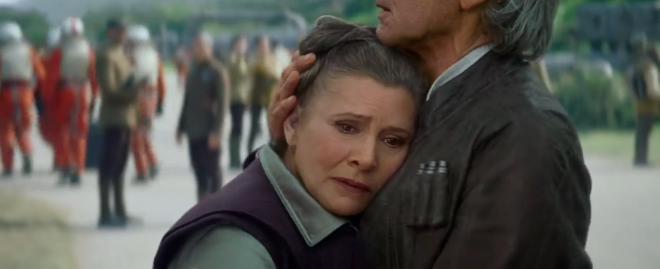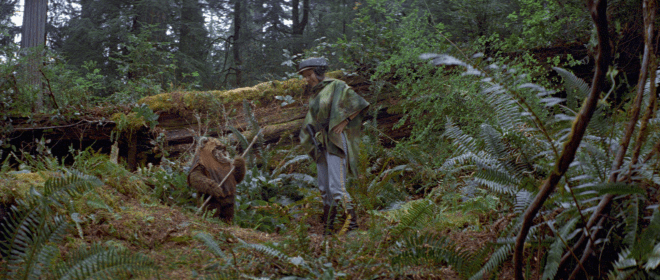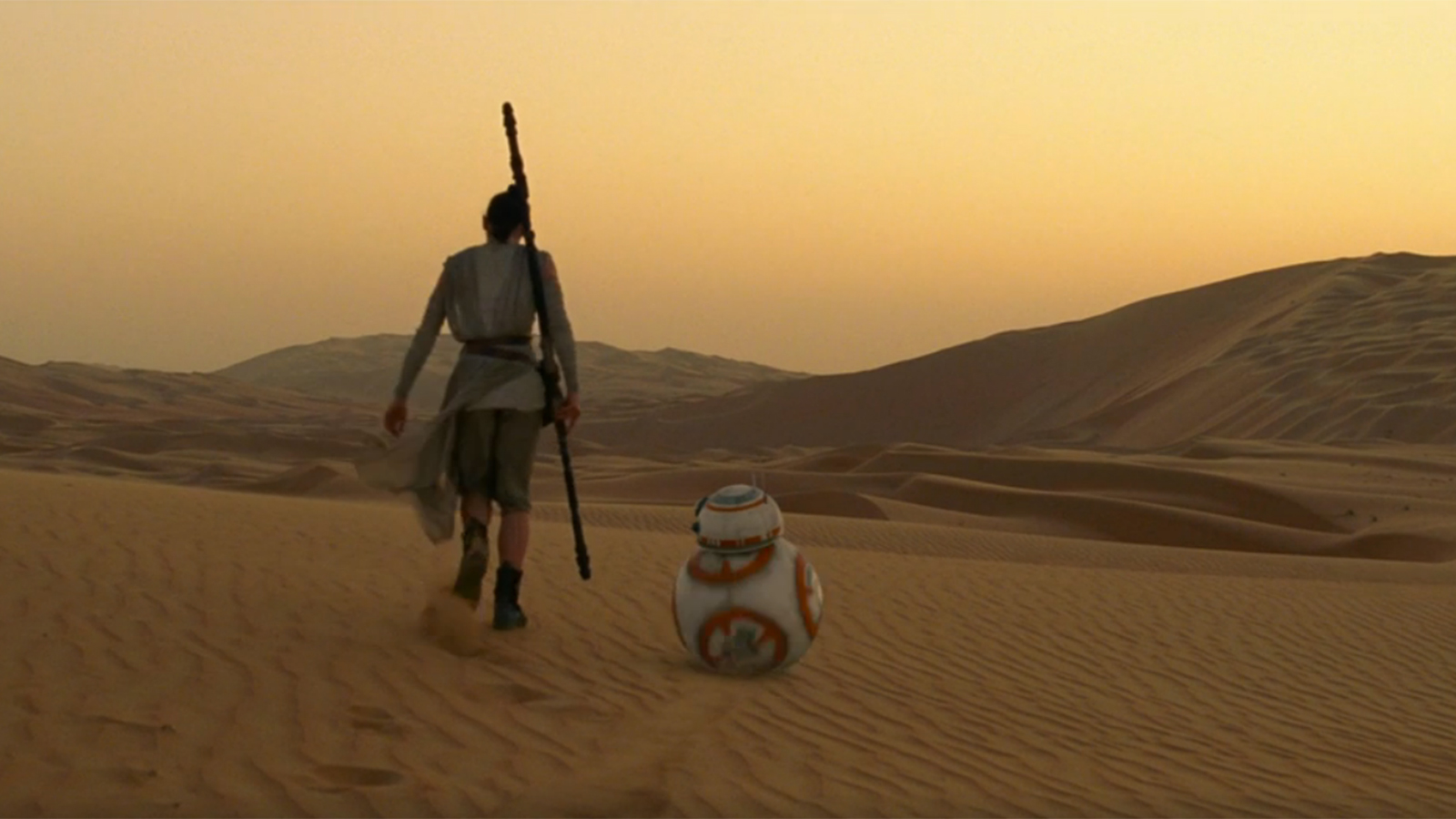Warning: There is information in this article that could be considered spoiler-ish, if America continues its astonishing ability to keep its mouth shut about this movie. I tried not to give away the really juicy stuff.
I hadn’t planned to see Star Wars: The Force Awakens until the hype died down. But I live in a Star Wars-infused household, and it became obvious after my fella saw it on opening night that conversation was going to be strained until we could hash over the latest installment together. So I went the next day, Bowling Alone-style: Drove in my car, by myself, to a megaplex. Walked across the sea of pavement trying not to hear what moviegoers who had just left the theater were saying. And walked out three hours later thinking about nothing but landscapes and what it means to be a woman. Which I’m sure is exactly what J.J. Abrams had in mind.
For a movie franchise set in space, Star Wars has always put a lot of emphasis on terra firma. Say what you will about George Lucas, the guy had a knack for including nature in his viewer-bludgeoning arsenal. He chose some stunning places to film, as this slideshow my friend helped put together for Budget Travel shows, and he used those settings to reinforce emotion. Awe, despair, fear, hope — they all played out against barren deserts, bustling cities, Arctic wastelands, and lush forests. Space was really secondary to place.
The Force Awakens is no different. If anything, J.J. Abrams has turned things up a notch. Actually, this seemed to be his MO with the entire movie: “Oh, you had a creepy holographic mastermind? I have one who’s creepy too, and freakin’ huge. You had a bad-guy weapon that could destroy a planet? I’ve got one that can destroy the entire universe … and it’s freakin’ huge.” Call it a classic case of lightsaber envy.
In that vein, the use of landscape seems to have also been huge-ified. A thundering bad-guy speech is delivered in the middle of a frozen, snow-swept mountain range. Thirst-inducing expanses of sand provide the background for a main character’s hopeless, poverty-stricken existence. When that character glimpses a forest canopy for the first time, she sees both hope and opportunity, murmuring, “I never knew there was so much green in the galaxy.” A climactic battle — central not only to the plot but also to the development of the combatants’ respective understanding of their abilities — occurs in a tangled, snowy forest. An island that plays a pivotal part in the movie is rocky, steep, isolated — and also impossibly verdant.
Heavy-handed as they are, the locations are undeniably gorgeous. They are grander in scale than in the old movies, if memory serves (I haven’t rewatched the trilogies lately, but hey, the holidays are coming). You see the whole mountain range instead of just the snowy space between the peaks; the whole seascape instead of just the island. Given all this gorgeousness, I spent a lot of time studying the scenes behind the action. (I have to admit this isn’t the first time I’ve spent precious energy thinking too hard about this topic; I might have had a hand in this old April Fools’ Ask Umbra column about what the Star Wars planets can teach us.)
But the landscape that moved me the most wasn’t forest or island or desert or mountain. It wasn’t one that inspired a location scout to text J.J. Abrams. And it wasn’t one I expected to care about at all.
It was Carrie Fisher’s face.
The notion that ol’ Carrie was a landscape in and of herself came to me the day after I saw the movie. Thinking I was forcing a pretty lousy metaphor, but figuring other people had probably forced the same lousy metaphor, I did some Googling. One of the first results was this quote: “There’s nothing more interesting than the landscape of the human face.”
Would you like to know who said that? You would. Because it was Irvin Kershner. As any diehard Star Wars fan could tell you, Kershner was the director of The Empire Strikes Back.

General Organa (bka Leia) in “The Force Awakens.”Lucasfilm Ltd.
I’ve never thought of Carrie Fisher as a particularly great actor, or given her much thought at all. But the moment she appeared in The Force Awakens — and it takes a while for that moment to arrive — I was reduced to a puddle. Harrison Ford had already shown up, shot off his usual wisecracks, grinned slyly a few times, and done justice to the aging hero thing. But Fisher barely spoke on arrival, and she didn’t have to. Her first scene was one of reunion and reflection and just plain old exhaustion. It’s hard work running the rebellion, especially when the latest villain is someone particularly close to you, and it takes energy to manage all the relationships and decisions and worries that go along with that responsibility. Also, re-creating a role you last embodied 32 years earlier as a hot young thing? Challenging in more than a few ways.
Every time she was on the screen from then on out, I welled up. OK, fine, I wept. So did the Woman of a Certain Age next to me. All around us, dudes were transfixed by explosions and gun battles and one-liners. (Actually, the one-liners were great.) And here sat this woman and I, watching Star Wars as if it were Terms of Endearment.
This was not the reaction I had expected to have. The more I thought about it later, the more I realized Carrie Fisher has been some kind of inadvertent navigational device for women who grew up in the 1970s and 1980s. I know, shut up, I’m laughing too. But for a kid watching Star Wars, she was the kind of ass-kicking, wise-cracking person you hoped you might grow up to be. (I should note that Rey, the young female protagonist in The Force Awakens, provides an even stronger model of independence and smarts for today’s young girls — and boys, for that matter.) When we were in high school and college, When Harry Met Sally brought Leia to the city — a little older, a little wiser, and more worried about relationships than rebellion. Now here we are in 2015, and she is everything rolled together: committed rebel, powerful professional, wise-but-loving ex, worried mother. You get the feeling that you could hug her, but you definitely shouldn’t fuck with her. Her life hasn’t turned out quite as she’d imagined, but she’s damn well going to keep trying to right it.
It’s all on her face, in every scene. Because here’s what else J.J. Abrams apparently has over George Lucas: An understanding of what it means to be human. I have an admittedly slippery new theory that those directorial instincts are heightened by his own precarious perch on the sands of time: Abrams turned 49 as he put the finishing touches on the film. And it turns out Fisher is 59. So maybe coming up on milestone birthdays makes both of them more sensitive to questions of mortality and human landscapes and what it means to live and love and regret and reconsider.

Princess Leia exchanging some words with an Ewok in “Return of the Jedi.”Lucasfilm Ltd.
As someone who hit a milestone birthday myself not too long ago, I’ve been giving more thought than usual to what aging means, especially for women. I’m no ingénue. Parts of me are less taut than they used to be. I worry about things I never thought I’d worry about: mortgage, gutters, why there are ants in the bathroom, whether my kids are kind to others when I’m not around. To say nothing of climate change and the violence and fear that are rattling our society. Frankly, it can all feel like too much.
So I’ve had to actively remind myself a lot recently: Along with the accumulated space junk of life, the years you spend on this planet earn you more wisdom, and more confidence, and more knowledge, and more love than you ever thought you could hold. The more mountains you climb and deserts you traverse, and the more crumpled your map, the more you gain. It’s not a new idea. I just never thought I’d find a reinforcement of it in Carrie Fisher’s face.
Like its predecessors, the new Star Wars uses landscape in bold, breathtaking ways — a respect for nature that’s worth appreciating. But this episode adds human nature into the mix, creating an even more complicated and truer map of the universe. As artistic evolution goes, that’s freakin’ huge.


